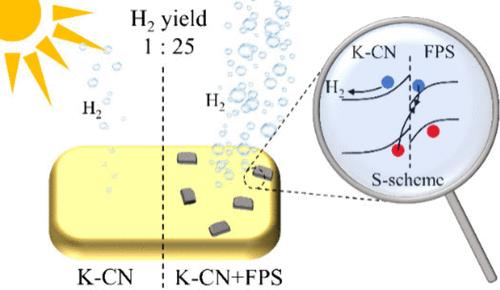当前位置:
X-MOL 学术
›
ACS Appl. Mater. Interfaces
›
论文详情
Our official English website, www.x-mol.net, welcomes your
feedback! (Note: you will need to create a separate account there.)
S-Scheme Interface Between K–C3N4 and FePS3 Fosters Photocatalytic H2 Evolution
ACS Applied Materials & Interfaces ( IF 8.3 ) Pub Date : 2024-11-18 , DOI: 10.1021/acsami.4c15236 Philipp Bootz, Kilian Frank, Johanna Eichhorn, Markus Döblinger, Tanu Bagaria, Bert Nickel, Jochen Feldmann, Bharati Debnath
ACS Applied Materials & Interfaces ( IF 8.3 ) Pub Date : 2024-11-18 , DOI: 10.1021/acsami.4c15236 Philipp Bootz, Kilian Frank, Johanna Eichhorn, Markus Döblinger, Tanu Bagaria, Bert Nickel, Jochen Feldmann, Bharati Debnath

|
In photocatalysis, photogenerated charge separation is pivotal and can be achieved through various mechanisms. Building heterojunctions is a promising method to enhance charge separation, where effective contact and charge exchange between heterojunction components remains challenging. Mostly used synthesis processes for making heterostructures require high temperatures, difficult processes, or expensive materials. Herein, a heterojunction of potassium intercalated graphitic carbon nitride (K-CN) and nanoflakes of iron phosphor trisulfide (FPS) is designed via a simple mechanical grinding process to boost the hydrogen evolution by a factor of more than 25 compared to pure K-CN. This significant improvement is rarely reached by other combinations of two semiconductors without cocatalysts, such as platinum. It can be attributed to the band alignment and band bending of an S-scheme that is validated via optical and X-ray photoelectron spectroscopy. As a consequence, strong quenching of the photoluminescence and significant H2 evolution occur for this unique heterojunction. Furthermore, the excellent durability of the designed photocatalytic heterostructure is confirmed by monitoring the catalysts’ H2-evolution rate and crystal structure after 72 h under light illumination. This study opens up promising and simple pathways for constructing efficient S-scheme heterojunctions for photocatalytic water-splitting.
中文翻译:

K–C3N4 和 FePS3 之间的 S 型界面促进光催化 H2 析出
在光催化中,光生电荷分离至关重要,可以通过各种机制实现。构建异质结是增强电荷分离的一种很有前途的方法,其中异质结组件之间的有效接触和电荷交换仍然具有挑战性。大多数用于制造异质结构的合成工艺需要高温、困难的工艺或昂贵的材料。在此,通过简单的机械研磨工艺设计了钾插层石墨氮化碳 (K-CN) 和磷三硫化物纳米薄片 (FPS) 的异质结,与纯 K-CN 相比,将析氢提高了 25 倍以上。这种显著的改进很少能通过两种没有助催化剂的半导体(如铂)的其他组合来实现。它可以归因于 S 方案的能带对齐和能带弯曲,该方案通过光学和 X 射线光电子能谱进行了验证。因此,这种独特的异质结会发生光致发光的强猝灭和显着的 H2 析出。此外,通过在光照下监测催化剂的 H2 析出速率和晶体结构,证实了所设计的光催化异质结构的优异耐久性。这项研究为构建用于光催化分解水的高效 S 型异质结开辟了有前途的简单途径。
更新日期:2024-11-18
中文翻译:

K–C3N4 和 FePS3 之间的 S 型界面促进光催化 H2 析出
在光催化中,光生电荷分离至关重要,可以通过各种机制实现。构建异质结是增强电荷分离的一种很有前途的方法,其中异质结组件之间的有效接触和电荷交换仍然具有挑战性。大多数用于制造异质结构的合成工艺需要高温、困难的工艺或昂贵的材料。在此,通过简单的机械研磨工艺设计了钾插层石墨氮化碳 (K-CN) 和磷三硫化物纳米薄片 (FPS) 的异质结,与纯 K-CN 相比,将析氢提高了 25 倍以上。这种显著的改进很少能通过两种没有助催化剂的半导体(如铂)的其他组合来实现。它可以归因于 S 方案的能带对齐和能带弯曲,该方案通过光学和 X 射线光电子能谱进行了验证。因此,这种独特的异质结会发生光致发光的强猝灭和显着的 H2 析出。此外,通过在光照下监测催化剂的 H2 析出速率和晶体结构,证实了所设计的光催化异质结构的优异耐久性。这项研究为构建用于光催化分解水的高效 S 型异质结开辟了有前途的简单途径。


















































 京公网安备 11010802027423号
京公网安备 11010802027423号